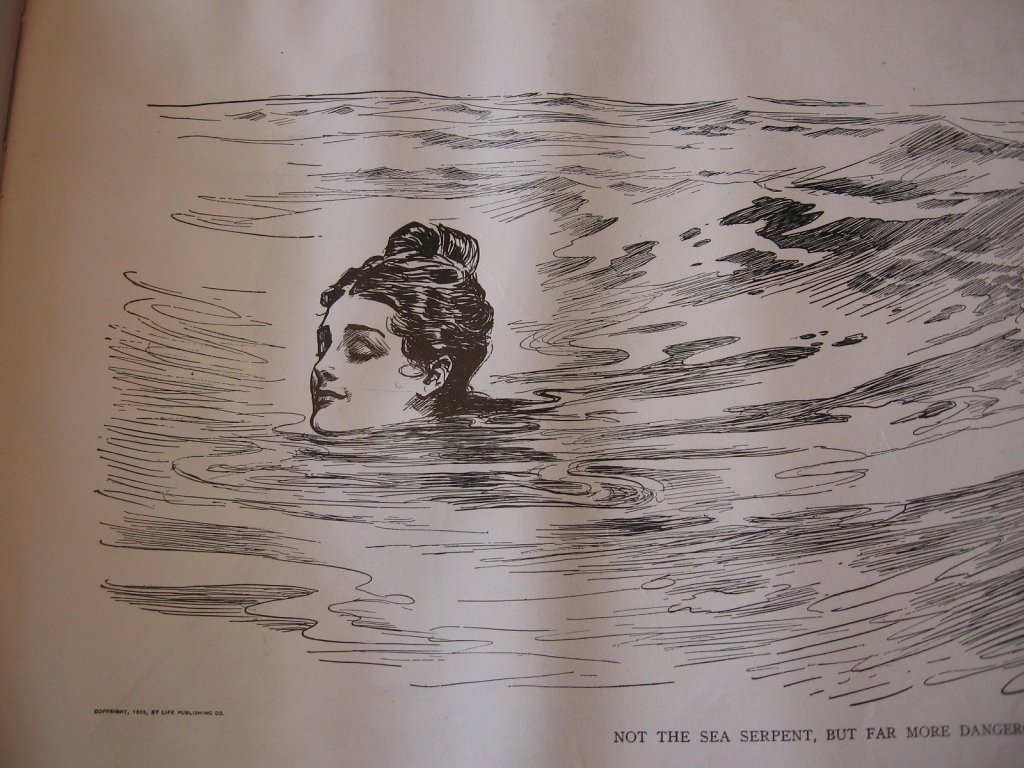She has been called the 19th Century’s answer to the Barbie, and the precursor of the flapper, a Victorian Betty Boop. She’s the Gibson Girl, and her appearance at the beginning of the 20th Century was a sure sign things would be very different for American women by the time that century was over.
In the 20 years between 1895 and the First World War, Charles Dana Gibson’s illustrations involving beautiful, confident young woman were the talk of America. Since she was nameless, she became known as the “Gibson Girl,” and she was very different from the demure, prudish, stodgy Victorian ladies who came before her.
The Gibson Girl might still have worn the swan-bill corset of the day that gave women that S-shaped silhouette, but her fashions were cutting edge and she wore her hair loosely fastened, romantic pile high on her head. This emphasized her long neck, and her cute little turned up nose gave her an air of aloofness without being haughty.
The Gibson Girl’s style, attitude, became a model for young women across the country. She became the standard of beauty for an entire generation. It’s difficult to overstate her influence. Her image appeared on china, pottery, matchbooks and wallpaper. She even changed the face on the revered old cameo.
Cameos traditionally depicted Greco-Roman goddesses, with classical aquiline noses and hair done up in what we would call an “Empire” style. But during the Gibson Girl rage, more of those profiles features the long neck, upturned nose and piled high hair of the Gibson Girl.
Charles Dana Gibson (1867-1944) was born in Massachusetts and moved to Flushing, NY as a young child. He studied art in New York City, eventually selling his first illustration to Life magazine when he was only 19-years-old. His Gibson Girl illustrations subsequently appeared in such pace-making magazines of the day as and Scribner’s, Harpers, and Colliers. He eventually became the owner and editor of Life.
It is speculated that Gibson drew inspiration for his Gibson Girl from his wife, Mary Langhorne, and her sister, Nancy Astor, who became the first female Member of Parliament in the British House of Commons.
Gibson’s prints usually sell unframed for about $50-$75, unframed. Simply framed prints may sell from $125-$225.These are usually book plates from one of the several compilations Gibson produced during his lifetime.
Mark your calendar in March if you have things you would like to have appraised. On March 16, I will be doing public appraisals on behalf of the Chamber of Commerce of Greater Cape May at Convention Hall from 11a.m. until 3 p.m. The limit is two items per person, and there’s a voluntary donation of $5 for the both. This will be part of a larger expo, so it sounds like fun. Call Doreen Talley at the Chamber at 609-884-5508 for more info.
On March 22, I will be at the Cape May Lutheran Church on Pittsburgh Avenue in Cape May City doing appraisals for the Mid-Atlantic Center for the Arts. Call Barbara Oberholtzer at MAC at 609-884-5404 for more info.
As usual, I will be taking photos at each of these events, and reporting the appraisals back in a future column. The more we see, the more we learn.
Arthur Schwerdt, a certified appraiser, is the author of “The Antique Story Book: Finding the Real Value of Old Things,” and co-owner of The August Farmhouse Antiques on Route 9 in Swainton. Send your comments, questions and appraisal requests to: aschwerdt@cmcherald.com.
West Wildwood – I see Sweden has cancelled the proposed windmills off their shores. This follows the overwhelming majority of fellow West Wildwood residents who have denounced the plan to place windmills along the…








